Simulate an artificial image#
The goal of this notebook is to simulate an artificial image of a star field at RA=280 deg, Dec=0 deg. This will familiarize you with the data-generating process of an astronomical image, especially helping you understand how bias, dark, read-out noise, and sky background affect the final image. At the end of this notebook, you will play with an interactive tool to simulate a realistic image of any given exposure time, sky background, read-out noise, bias value, dark current, and seeing condition. Have fun!
Prerequisites
Basic statistics
Knowledge about CCD, bias, dark, and flat frames
Finished the “Calibration frame” notebook
We will learn
Understand the data generating process of an astronomical image
Point Spread Function and 2-D Gaussian function
World Coordinate System (WCS) and how to convert (RA, DEC) on the sky to (x, y) on the image
How to write docstrings for your functions
# Don't worry about this cell, it's just to make the notebook look a little nicer.
try:
import google.colab
IN_COLAB = True
except ImportError:
IN_COLAB = False
# Get the directory right
if IN_COLAB:
# Download utils.py
!wget -q -O /content/utils.py https://raw.githubusercontent.com/AstroJacobLi/ObsAstGreene/refs/heads/main/book/docs/utils.py
# Function to check and install missing packages
from google.colab import drive
drive.mount('/content/drive/')
os.chdir('/content/drive/Shareddrives/AST207/data')
!wget https://github.com/jgreene100/Ast207/raw/refs/heads/main/book/_static/ObsAstroData/simulate_star_cat.fits
else:
sys.path.append('../../docs/')
os.chdir('../../_static/ObsAstroData/')
import os, sys
sys.path.append('../')
import numpy as np
from matplotlib import pyplot as plt
from utils import show_image
# fix a random number generator
np.random.seed(42) # 42 is the answer to the Universe.
# We can beautify our plots by changing the matpltlib setting a little
plt.rcParams['font.size'] = 18
plt.rcParams['figure.figsize'] = (8, 6)
plt.rcParams['figure.dpi'] = 80
plt.rcParams['axes.linewidth'] = 2
1. Start with a blank image#
This is easy! We use np.zeros to construct an array full of zeros. We will add signals and noises as we proceed.
synthetic_image = np.zeros([500, 500])
show_image(synthetic_image, cmap='gray', show_colorbar=True, figsize=(6, 6))
<Axes: >
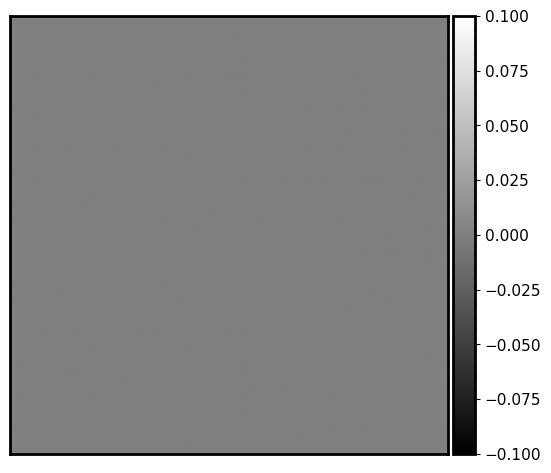
2. Generate calibration frames#
2.1 Read-out noise#
When we read out an image from a CCD, some small random noise is added to each pixel. This “read-out” noise follows a Gaussian distribution centered at zero. Typically you can find the “width” of this Gaussian in the CCD operating manual. For example, let’s assume that the CCD manual said the read-out noise is READ NOISE: 4e- rms and the gain we used is GAIN = 2 e- / ADU. This means that the standard deviation of the read-out noise is 4 electron per read-out. Read noise of a CCD is almost always given in electrons, but images are typically in counts (ADUs). To convert electrons to counts (ADUs), we have to devide the number of electrons by gain (electrons per count). Therefore, the standard deviation of read-out noise in counts is 2.
Below we write a function read_noise to generate the read-out noise to be added to the blank image that we generated above. Note that each time you run this function you’ll get a different set of pixels so that it behaves like real noise.
def read_noise(image, amount, gain=2):
"""
Generate simulated read noise.
Parameters
----------
image: numpy array
To which we add the read noise.
amount : float
The rms of read noise, in electrons.
gain : float, optional
Gain of the camera, in units of electrons/ADU.
Returns
-------
noise: numpy array
The read noise frame
"""
shape = image.shape
noise = np.random.normal(scale=amount / gain, size=shape)
return noise
noise_im = synthetic_image + read_noise(synthetic_image, 4, gain=2)
fig = show_image(noise_im, cmap='gray', show_colorbar=True, figsize=(6, 6))
fig.set_title('Read noise', fontsize='20')
Text(0.5, 1.0, 'Read noise')
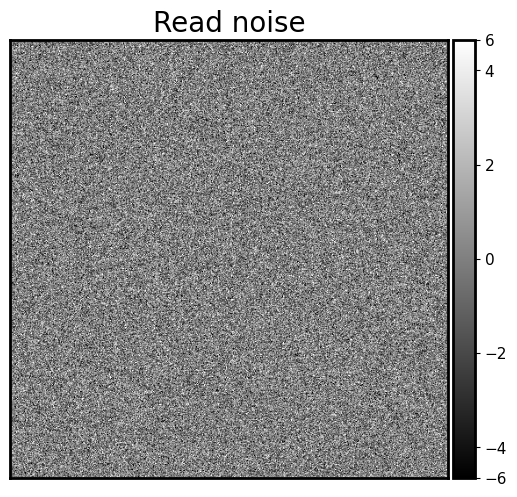
Nice! We get a beautiful noise image :)
Exercise 1#
Plot the histogram of the pixel values of the above image. Also estimate the median and the standard deviation of the pixel value distribution.
# your answer
2.2 Bias#
As we have already discussed in Calibration Frames, bias is a positive offset added to each pixel to make sure the counts are non-negative. If there is no this offset, as we see in the above image, some pixels are negative.
As shown in Calibration Frames, the bias value is roughly the same across the CCD, but there is still some spatial patterns including “bad” columns. To model such a bias, we create a uniform array and add some “bad” columns (when you set realistic=True). Note that the bias is not a function of exposure time and does not have read-out noise.
def bias(image, value, realistic=False):
"""
Generate simulated bias image.
Parameters
----------
image: numpy array
The image to which the bias will be added
value: float
Bias level to add, in counts.
realistic : bool, optional
If ``True``, add some "bad" columns with higher bias value
Returns
-------
bias_im: numpy array
The bias frame
"""
shape = image.shape
# This is the bias frame with the same bias value for all pixels
bias_im = np.ones(shape) * value
# Try to add "bad" columns
if realistic:
# We want a random-looking variation in the bias, but unlike the readnoise the bias should
# not change from image to image, so we make sure to always generate the same "random" numbers.
rng = np.random.RandomState(seed=0)
number_of_colums = rng.randint(3, 9)
# Randomly select which columns are bad
columns = rng.randint(0, shape[1], size=number_of_colums)
# This will add a little random-looking noise into the data.
# This `col_pattern` is added to the global bias value to represent "bad" columns
col_pattern = rng.randint(0, int(0.03 * value), size=shape[0])
for c in columns:
# Here `c` is the index of "bad" columns
bias_im[:, c] = value + col_pattern
return bias_im
bias_only = bias(synthetic_image, 1100, realistic=False)
fig = show_image(bias_only, cmap='gray', show_colorbar=True, figsize=(6, 6))
fig.set_title('Bias alone, no bad columns', fontsize=15)
Text(0.5, 1.0, 'Bias alone, no bad columns')
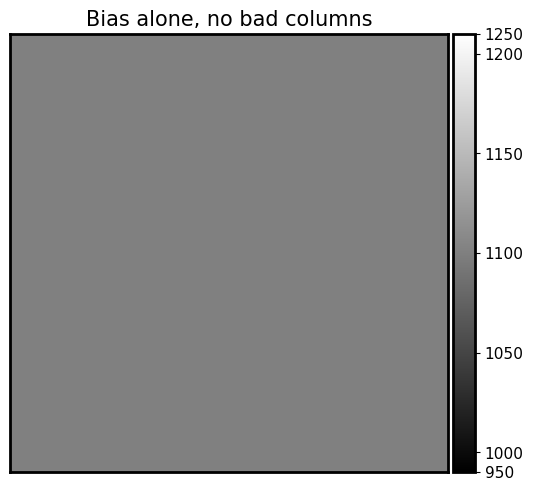
Now create realistic bias frame by adding bias and read noise together. Note that we did not include any cosmic rays.
fig = show_image(noise_im + bias_only, cmap='gray', figsize=(6, 6), show_colorbar=True)
fig.set_title('Realistic bias frame', fontsize=20)
Text(0.5, 1.0, 'Realistic bias frame')
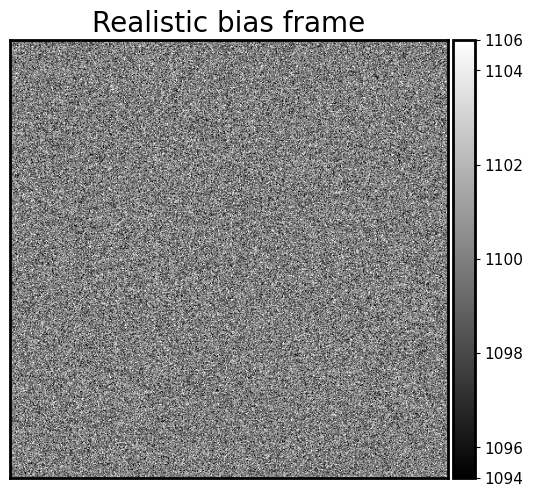
Exercise 2#
Plot the histogram of pixel values in the above
bias frame. Also calculate the median and standard deviation. Compare them with Exercise 1.Generate a bias frame with bad columns (i.e., set
realistic=True). That’s more or less the real bias frame from an astronomical CCD.
# your answer
2.3 Dark frame#
For modern cooled CCD, the dark current is typically very small (0.1 electrons/pixel/second or less). Dark counts in the function below are calculated by multiplying the dark current by the exposure time after converting the dark current unit from electrons to counts using the gain. Notice that the dark counts follow a Poisson distribution. So it will look noisy.
However, as we seen in Calibration Frames, some pixels as “hot” pixels. Their dark current is much larger than the other pixels.
The function below simulates dark current only, i.e. it does not simulate the read noise that is a part of any actual dark frame from a CCD.
def dark_current(image, current, exposure_time, gain=2, hot_pixels=True):
"""
Simulate dark current in a CCD, optionally including hot pixels.
Parameters
----------
image : numpy array
The image array used to determine the shape of the dark frame.
current : float
Dark current, in electrons/pixel/second, which is the way manufacturers typically report it.
exposure_time : float
Length of the simulated exposure, in seconds.
gain : float, optional
Gain of the camera, in units of electrons/ADU.
hot_pixels : bool, optional
Whether to include hot pixels or not.
Returns
-------
dark_im: numpy array
The dark frame, without read noise and bias
"""
# dark current for every pixel. Real dark counts follow
# a Poisson distribution with lambda = base_current.
base_current = current * exposure_time / gain
dark_im = np.random.poisson(base_current, size=image.shape)
if hot_pixels:
n_hot = np.random.randint(5, 50) # number of hot pixels
y_max, x_max = dark_im.shape
# For a given CCD, the positions of hot pixels are not changing.
# So we set a random number seed to ensure we get the same hot pixels every time.
rng = np.random.RandomState(seed=0)
hot_x = rng.randint(0, x_max, size=n_hot)
hot_y = rng.randint(0, y_max, size=n_hot)
hot_current = base_current * 100 # 100 times hotter than the base dark current
dark_im[(hot_y, hot_x)] = hot_current
return dark_im
dark_exposure = 900
dark_cur = 0.1
dark_only = dark_current(synthetic_image, dark_cur, dark_exposure, hot_pixels=True)
fig = show_image(dark_only, cmap='gray', figsize=(6, 6), show_colorbar=True)
title_string = f'Dark current only, {dark_cur} $e^-$/sec/pix\n{dark_exposure} sec exposure'
fig.set_title(title_string, fontsize=20)
Text(0.5, 1.0, 'Dark current only, 0.1 $e^-$/sec/pix\n900 sec exposure')
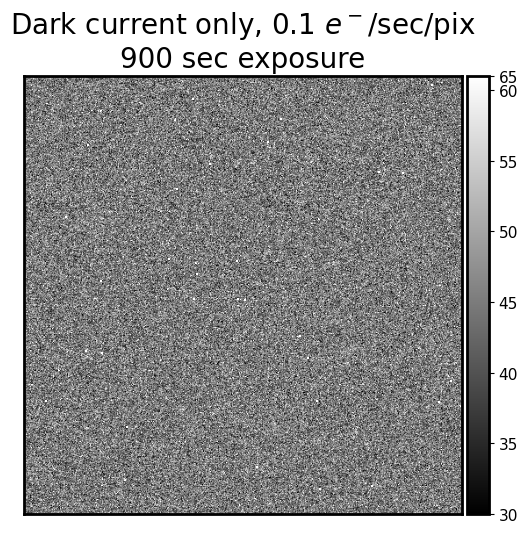
Realistic dark frame is a combination of all of them: bias-only, read-out noise, and dark-only
fig = show_image(dark_only + bias_only + noise_im, cmap='gray', figsize=(6, 6), show_colorbar=True)
fig.set_title('Realistic dark frame \n(with bias, read noise)', fontsize=20)
Text(0.5, 1.0, 'Realistic dark frame \n(with bias, read noise)')
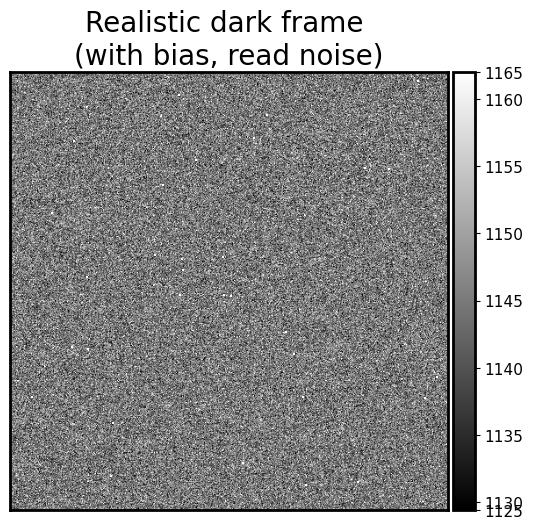
It looks quite real! However, we did not include any cosmic rays and flat field.
Exercise 3#
Repeat the same exercise, plotting the histogram, and calculating the median and standard deviation. Is the dark frame noisier than the bias frame?
# your answer
2.4 Sky background#
The amount of sky background depends on the atmospheric conditions (humidity, presence of light clouds, etc.), the light sources in the sky (the Moon) and lights from the surrounding area. It may or may not be uniform across the field of view. The sky brightness on Mauna Kea in the V band is \(\mu_V \approx 21.5\ \mathrm{mag/arcsec}^2\).
The function below generates a homogeneous sky background in the field of view. The photons from sky background also follow a Poisson distribution. The sky counts also scales with exposure time.
def sky_background(image, sky_counts_per_sec, exposure_time, gain=2):
"""
Generate a flag sky background.
Parameters
----------
image : numpy array
The input image. Only its shape is used.
sky_counts_per_sec : float
The target value for the number of counts per second from the sky.
exposure_time : float
Length of the simulated exposure, in seconds.
gain : float, optional
Gain of the camera, in units of electrons/ADU.
Returns
-------
sky_im : numpy array
The simulated image for the sky background.
"""
sky_im = np.random.poisson(sky_counts_per_sec * gain * exposure_time, size=image.shape) / gain
return sky_im
sky_level = 0.5 # counts per sec
sky_only = sky_background(synthetic_image, sky_level, exposure_time=900, gain=2)
fig = show_image(sky_only, cmap='gray', figsize=(6, 6), show_colorbar=True)
fig.set_title(f'Sky background only, {sky_level} counts input', fontsize=20)
Text(0.5, 1.0, 'Sky background only, 0.5 counts input')
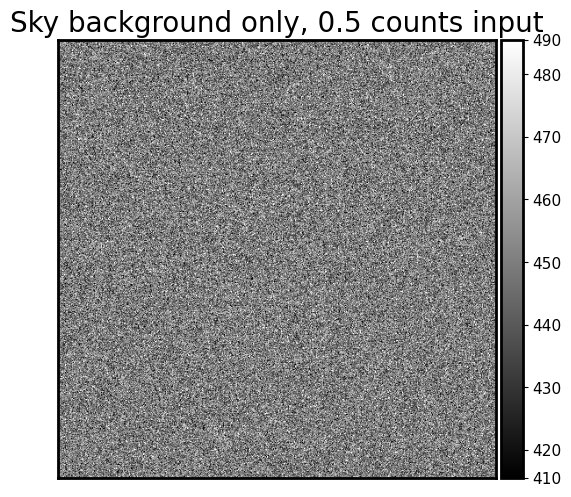
Nice! Let’s combine sky_only with dark current, bias, and read-out noise to make our “sky” more realistic. This is how the image of clouds look like.
fig = show_image(sky_only + dark_only + bias_only + noise_im,
cmap='gray', figsize=(6, 6), show_colorbar=True)
fig.set_title('Sky, dark, bias, and read noise \n (aka an image of the sky w/o stars)', fontsize=20)
Text(0.5, 1.0, 'Sky, dark, bias, and read noise \n (aka an image of the sky w/o stars)')
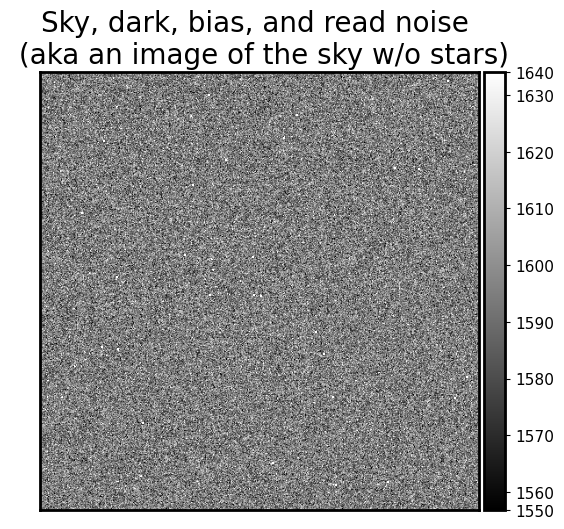
Exercise 4#
Repeat the exercise of plotting the histogram, and calculating the median and standard deviation. Is the sky frame even noisier than the dark frame?
(Optional) What’s the role of
gainin functionsky_background()? If the argumentsky_counts_per_secis in counts, why do we needgainin this function?
# your answer
2.5 Signal-to-noise ratio#
We have already played with signal-to-noise ratio (SNR) in Basic Statistics (Part 1). Let’s review it in a more realistic astronomical context.
As we already learned from Basic Statistics (Part 1) and the above cells, the counts from astronomical objects, sky background, and dark current all follow Poisson distribution. Let’s now take a look at the the signal-to-noise ratio and how that scales with the exposure time. In the exercise below, we simply study the signal on one pixel. The signal comes from a star (with star_flux in e-/s), the sky background (sky_flux, in e-/s), and readout noise (sigma_read, in e-).
# Let's assume the following values:
star_flux = 20 # e- / s
sky_flux = 0.5 # e- / s
sigma_read = 4 # e- / s
t_exp = 1 # s
Now let’s see what’s the total signal we receive on this pixel:
star_signal = star_flux * t_exp
sky_signal = sky_flux * t_exp
read_signal = 0
total_signal = star_signal + sky_signal + read_signal
We note that the readout noise doesn’t contribute to the signal, since the average value of the readout noise is zero. However, it contributes to the “noise”. The noises from sky and star are all Poisson. Because these noises are independent, we can add the standard deviations in quadrature:
star_noise = np.sqrt(star_signal)
sky_noise = np.sqrt(sky_signal)
read_noise = sigma_read
total_noise = np.sqrt(star_noise**2 + sky_noise**2 + read_noise**2)
Now we can define the signal-to-noise ratio:
SNR = total_signal / total_noise
Let’s see what’s the SNR for the above situation:
star_signal = star_flux * t_exp
sky_signal = sky_flux * t_exp
read_signal = 0
total_signal = star_signal + sky_signal + read_signal
star_noise = np.sqrt(star_signal)
sky_noise = np.sqrt(sky_signal)
read_noise = sigma_read
total_noise = np.sqrt(star_noise**2 + sky_noise**2 + read_noise**2)
SNR = total_signal / total_noise
print(f"SNR = {SNR}")
SNR = 3.3931841432697087
Great! This means that the star’s signal is about 3 times brighter than the noise. A SNR=3 detection is not so great. What if we increase the exposure time?
t_exp = 10 # s
star_signal = star_flux * t_exp
sky_signal = sky_flux * t_exp
read_signal = 0
total_signal = star_signal + sky_signal + read_signal
star_noise = np.sqrt(star_signal)
sky_noise = np.sqrt(sky_signal)
read_noise = sigma_read
total_noise = np.sqrt(star_noise**2 + sky_noise**2 + read_noise**2)
SNR = total_signal / total_noise
print(f"SNR = {SNR}")
SNR = 13.789792276924405
Now the SNR is much higher and it means that we are very confident about detecting this star over noise. Now you can solve the following exercises:
Exercise 5#
Write the above code of calculating SNR to a function, like the following:
def calc_SNR(star_flux, sky_flux, sigma_read, t_exp): ### Your answer here ### return SNR
Using this function, calculate the SNR of the star when the exposure time is in
t_exps = np.linspace(1, 200, 50). Plot the SNR as a function of exposure time. What’s the best functional form to describe this relation? (Hint: you can plot theSNR-texprelation inloglogscale.)For this star, if you wanna double the SNR, should you also double the exposure time? Or triple the exposure time?
For a faint source with a short exposure time, what dominates the SNR (sky or read noise)?
3. Add real stars#
The images that we generated look quite boring so far. Shall we add some stars to it? Let’s do it.
In order to make it look very realistic, we prepared a catalog containing 307 stars around RA = 280 deg, Dec = 0 deg from the Gaia mission. The catalog has the RA, Dec, and the g-band flux (g_flux in electron/sec) of each star. There are three more things to do before we can inject these stars to the image:
We have to convert the sky coordinates
(RA, Dec)of stars to image coordinates(x, y). This can be done using “World Coordinate System (WCS)”. We build awcsinstance standing for the imaginary telescope we’re using. Then we use thiswcsto calculate image coordinates of the stars.We need to convert the flux in electron per second to counts given the gain and exposure time. This is easy:
counts = g_flux / gain * exposure_time.Stars are not a single point on the image. Instead, they are blobs, due to the Point Spread Function (PSF) of the optical system (including the atmosphere). Therefore, we need to build a PSF according to the seeing and scale this PSF to match the total counts of each star.
We will solve these problems one by one. We read the star catalog first. Again, g_flux is in electron / sec.
from astropy.table import Table
cat = Table.read('./simulate_star_cat.fits')
cat[:5]
| ra | dec | g_flux |
|---|---|---|
| deg | deg | |
| float64 | float64 | float32 |
| 280.00182067676167 | -0.0006054995504625365 | 1.5633024 |
| 280.00291787552493 | 0.001124410381860149 | 0.5670684 |
| 280.0004310363741 | -0.003360890132438791 | 0.2738112 |
| 280.00533847454955 | 0.0009738996826714352 | 0.5869863 |
| 279.99457484780316 | -0.0020924098806938255 | 0.2795567 |
3.1 WCS and image coordinates#
WCS is nicely introduced here. We assume that our “telescope” has a pixel scale of 0.5 arcsec / pixel, and assume the field of view has no distorion.
from astropy import wcs
pixel_scale = 0.5 # arcsec / pix
shape = synthetic_image.shape
# Create a new WCS object. The number of axes must be set from the start
w = wcs.WCS(naxis=2)
# Pixel coordinate of reference point.
# We set the ref point to be the center of the image.
w.wcs.crpix = [shape[1]/2, shape[0]/2]
# This is the coordinate increment (in deg) at reference point
w.wcs.cdelt = np.array([-pixel_scale / 3600, pixel_scale / 3600])
# This is the RA, Dec of the reference point
w.wcs.crval = [280, 0]
# This is the projection type.
# Since our FOV is quite small, this doesn't matter that much.
w.wcs.ctype = ["RA---TAN", "DEC--TAN"]
w
WCS Keywords
Number of WCS axes: 2
CTYPE : 'RA---TAN' 'DEC--TAN'
CRVAL : 280.0 0.0
CRPIX : 250.0 250.0
PC1_1 PC1_2 : 1.0 0.0
PC2_1 PC2_2 : 0.0 1.0
CDELT : -0.0001388888888888889 0.0001388888888888889
NAXIS : 0 0
We can use the function wcs_world2pix to convert sky coordinates to pixel coordinates.
xs, ys = w.wcs_world2pix(cat['ra'], cat['dec'], 0)
plt.scatter(xs, ys, s=5)
<matplotlib.collections.PathCollection at 0x147357710>
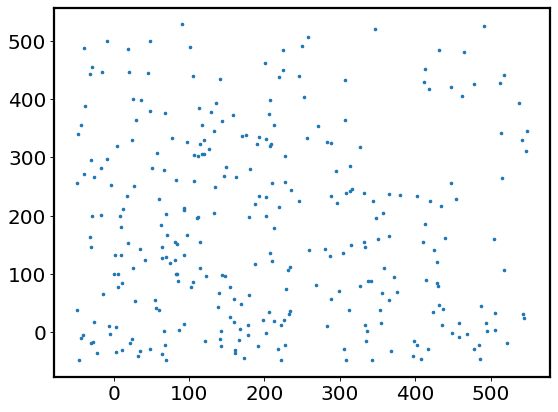
3.2 Point Spread Function (PSF)#
This is actually a huge topic. Maybe I should write another notebook on this.
We use a Gaussian function to describe the PSF of the “telescope” we use, although the PSF of real telescopes is not precisely Gaussian. The Gaussian function in 2-D is: \(f(x, y) = \frac{1}{2\pi \sigma^2} e^{-\frac{1}{2\sigma^2}\left[(x - x_0)^2 + (y - y_0)^2\right]}\). This is a normalized Gaussian function, i.e., \(\int_x \int_y f(x,y)=1\). Although you can write your own implementation, we use astropy.modeling.functional_models.Gaussian2D for convenience. As you may notice, for a normalized Gaussian, the amplitude in Gaussian2D should be \(\frac{1}{2\pi \sigma^2}\).
We know that the width of a Gaussian is described by \(\sigma\). In astronomy, the width of the PSF is often described by its Full Width at Half Maximum (FWHM). For a Gaussian function with \(\sigma\), its FWHM is \(2\sqrt{2\ln 2} \sigma \approx 2.355 \sigma\).
Below we show how to inject a normalized Gaussian PSF (i.e., a star whose total count = 1) to an image.
from astropy.modeling.functional_models import Gaussian2D
psf = Gaussian2D()
seeing = 1.5 # arcsec, FWHM of the PSF
sigma = seeing / 2.355 / pixel_scale # sigma of the Gaussian, in pixel
# To evaluate the PSF, we needs a grid of coordinates
# This can be generated using `np.mgrid`
shape = synthetic_image.shape
y, x = np.mgrid[:shape[1], :shape[0]]
single_star = psf.evaluate(x, y,
amplitude=1 / (2 * np.pi * sigma**2),
x_mean=250, y_mean=250,
x_stddev=sigma, y_stddev=sigma, theta=0)
print(np.sum(single_star))
plt.imshow(single_star)
# yeah... a tiny dot.
1.0000000000000488
<matplotlib.image.AxesImage at 0x147625f50>
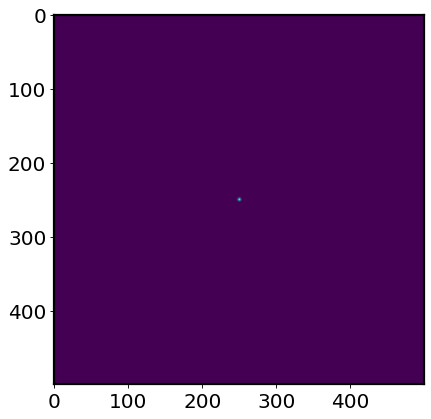
3.3 Let’s cook!#
We have all the ingredients! Let’s glue the above snippets together and write a function to inject stars from the catalog. Please note how we calculate counts from g_flux and how we sample the Poisson distributions.
A reminder: the final image is: $\( \text{Image = stars + sky + dark + bias + readnoise} \)$
def inject_stars(image, star_cat, w, exposure_time=900, gain=2, seeing=1.5):
"""
Inject stars to the input image
Parameters
----------
image : numpy array
The input image whose shape will be used to generate the output image.
star_cat : astropy table
The catalog of stars to be injected. Must contain columns of 'ra', 'dec', 'g_flux'.
`g_flux` is the flux of the star in the g-band in units of electron / sec.
w : astropy.wcs.WCS
The WCS of the input image.
exposure_time : float, optional
Exposure time of the image, in seconds.
gain : float, optional
Gain of the camera, in units of electrons/ADU.
seeing: float.
FWHM of the PSF, in arcsec.
Returns
-------
stars_real : numpy array
The image with stars injected.
"""
shape = image.shape
sigma = seeing / 2.355 / pixel_scale
# sigma of the Gaussian, in pixel
# Convert (RA, Dec) of stars to (x, y) based on the WCS info
xs, ys = w.wcs_world2pix(star_cat['ra'], star_cat['dec'], 0)
# These are the coordinates of each pixel of the image
y, x = np.mgrid[:shape[1], :shape[0]]
# Initialize the PSF
psf = Gaussian2D()
# Again, the counts should follow a Poisson distribution
# We first build an image showing the mean of this Poisson distribution
# Then sample the distribution
counts = star_cat['g_flux'] / gain * exposure_time
# Initialize an empty image
stars_img = np.zeros_like(image)
# Loop over stars
for i, count in enumerate(counts):
stars_img += psf.evaluate(x, y,
amplitude=count / (2 * np.pi * sigma**2),
x_mean=xs[i], y_mean=ys[i],
x_stddev=sigma, y_stddev=sigma, theta=0)
# Sample from Poisson based on the mean counts
stars_real = np.random.poisson(lam=stars_img)
return stars_real
stars_only = inject_stars(synthetic_image, cat, w,
exposure_time=900, gain=2, seeing=1.5)
fig = show_image(stars_only, cmap='gray', figsize=(7, 7))
fig.set_title('Stars only', fontsize=20)
Text(0.5, 1.0, 'Stars only')
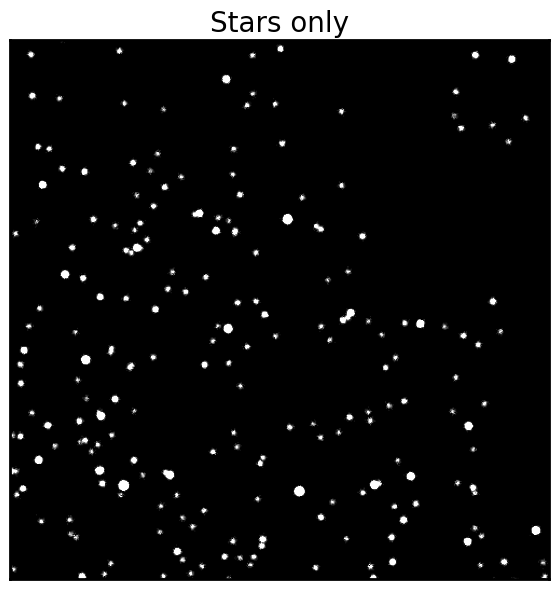
# Add everything together
realistic_img = stars_only + sky_only + dark_only + bias_only + noise_im
fig = show_image(realistic_img, cmap='gray', figsize=(7, 7))
fig.set_title('Realistic image at RA = 280 deg, Dec = 0 deg \n exptime = 900 s', fontsize=20)
Text(0.5, 1.0, 'Realistic image at RA = 280 deg, Dec = 0 deg \n exptime = 900 s')
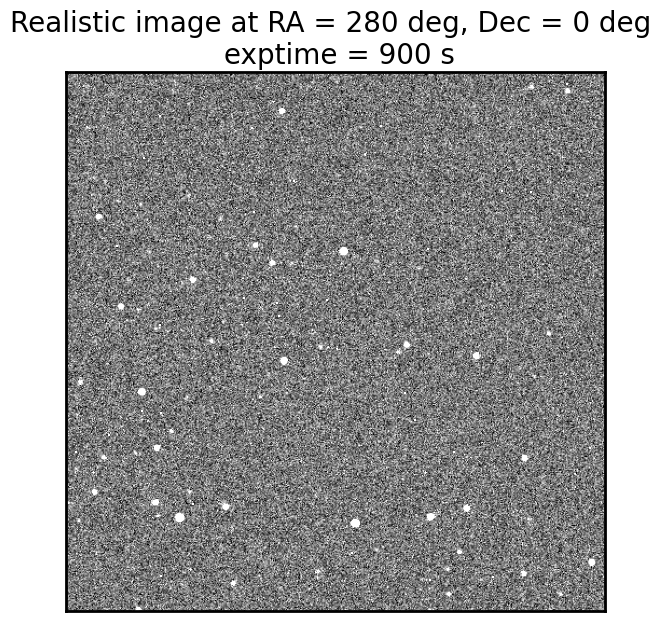
Exercise 6#
Plot the histogram of all pixels in
realistic_img, also calculate median and standard deviation. Compare with all the above results, and comment.“Image reduction”. With the
realistic_imggenerated above, let’s pretend that it’s observed with a telescope. And now our job is to “reduce” this data by subtracting bias, dark, and sky.Let’s pretend that the bias, dark, and sky all can be represented by a single number like:
bias_value = np.median(bias_only) sky_value = np.median(sky_only) dark_value = np.median(dark_only)
Please subtract the bias, dark, and sky values from the
realistic_img. Then plot this image. It’s beautiful, isn’t it?
# your answer
Interactive demo#
You can play with different combinations of all parameters. Change each of them independently to build intuition on how these parameters affect the final image. You might have to wait a few seconds each time you change the parameters.
This does not run directly on this website. You can download the notebook and run it locally, or run it on Google Colab. It might be quite slow (depending on the machine).
If it runs well, you can try to change exposure time, seeing, and sky brightness. They will change how the image look quite interestingly.
from ipywidgets import interactive, BoundedFloatText
def complete_image(bias_level=1100, read=10.0, gain=1.0, dark=0.1,
exposure=300, sky_counts_per_sec=0.3,
seeing=1.5):
synthetic_image = np.zeros([500, 500])
show_image(synthetic_image +
read_noise(synthetic_image, read, gain) +
bias(synthetic_image, bias_level, realistic=False) +
dark_current(synthetic_image, dark, exposure, gain) +
sky_background(synthetic_image, sky_counts_per_sec, exposure, gain) +
inject_stars(synthetic_image, cat, w, exposure, gain, seeing),
cmap='gray',
figsize=(6, 6))
i = interactive(complete_image,
bias_level=BoundedFloatText(value=1100, min=1000, max=1200, step=10),
dark=BoundedFloatText(value=0.1, min=0.01, max=1, step=0.01),
sky_counts_per_sec=BoundedFloatText(value=0.3, min=0, max=3, step=0.1),
gain=BoundedFloatText(value=1.0, min=0.5, max=3.0, step=0.1),
read=BoundedFloatText(value=10.0, min=0, max=50, step=2.0),
exposure=BoundedFloatText(value=300, min=100, max=12000, step=100),
seeing=BoundedFloatText(value=1.5, min=0.5, max=3, step=0.5)
)
for kid in i.children:
try:
kid.continuous_update = False
except KeyError:
pass
display(i)
Summary: Image generating process#
Symbolically, we simulate our “realistic” image using the following recipe. For a given pixel, the final count is
\( X_{\text{image}} = \text{bias} + X_{\text{read noise}} + X_{\text{dark current}} + X_{\text{sky}} + X_{\text{stars}} \)
Variables denoted as \(X_{?}\) are random variables – these quantities will change if you generate them again.
\(\text{bias}\) is a constant offset. Although it has pixel-to-pixel variation.
\(X_{\text{read noise}} \sim \mathcal{N}(0, \sigma_{\text{read}}^2)\) is a Gaussian noise
\(X_{\text{dark current}} \sim \mathcal{P}\text{oisson}\,(\lambda_{\text{dark}})\) follows a Poisson distribution. \(\lambda_{\text dark}\) should be in counts. If not, please use
gainto convert it to counts.\(X_{\text{sky}} \sim \mathcal{P}\text{oisson}\,(\lambda_{\text{sky}})\). Similar to dark current.
\(X_{\text{star}} \sim \mathcal{P}\text{oisson}\,(\lambda_{\text{star}})\). Similar to dark current and sky background.
Therefore, the “noise level” in the final image depends on \(\sigma_{\text{read}}, \lambda_{\text{dark}}, \lambda_{\text{sky}}, \lambda_{\text{star}}\).
Extracting the science photons (i.e. the stars) is in principle a matter of subtraction: \( X_{\text{stars}} = X_{\text{image}} - \text{bias} - X_{\text{dark current}} - X_{\text{sky}} + X_{\text{read noise}} \)
As we showed in calibration_frame.ipynb, read noise can be reduced by stacking lots of images.
Also, we have ignored flat fielding throughout this notebook. When considering it, we have \( X_{\text{image}} = \text{bias} + X_{\text{read noise}} + X_{\text{dark current}} + \text{flat} * (X_{\text{sky}} + X_{\text{stars}}). \) Flat fielding is a multiplicative effect.

